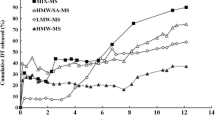Abstract
Controlled-release formulations based on poly(lactic) (PLA) and poly(lactic/glycolic) acid (PLGA) microspheres containing tetanus vaccine were designed. The polymers forming the microspheres were L-PLA of different molecular weights and DL-PLGA, 50:50. These microspheres were prepared by two solvent elimination procedures, both using a double emulsion, and were characterized for size, morphology, and toxoid release kinetics. The influence of formulation variables such as polymer type, vaccine composition, and vaccine/polymer ratio was also investigated. Both techniques yielded microspheres with similar size, morphology, and release properties. Microsphere size was dependent on the type of polymer and the presence of the surfactant L-α-phosphatidylcholine, which led to a reduction in microsphere size. On the other hand, the release kinetics of encapsulated protein were affected by the polymer properties (ratio lactic/glycolic acid and molecular weight) as well as by the vaccine composition, vaccine loading, and microsphere size. Moreover, for some formulations, a decrease in microsphere size occurred simultaneously, with an increase in porosity leading to an augmentation of release rate. The changes in the PLA molecular weight during in vitro release studies indicated that release profiles of tetanus toxoid from these microspheres were only marginally influenced by polymer degradation. A significant fraction of protein (between 15 and 35%) was initially released by diffusion through water-filled channels. In contrast, the decrease in the PLGA molecular weight over the first 10 days of incubation suggested that erosion of the polymer matrix substantially affects protein release from these microspheres. Among all formulations developed, two differing in microsphere size, polymer hydrophobicity, and release profile were selected for in vivo administration to mice. Administration of both formulations resulted in tetanus neutralizing antibody levels that were higher than those obtained after administration of the fluid toxoid.
Similar content being viewed by others
REFERENCES
D. A. Eppstein and J. P. Longenecker. Alternative delivery systems for peptides and proteins as drugs. CRC Critical Reviews in Therapeutic Drug Carrier Systems 5:99–139 (1988).
M. S. Hora, R. K. Rana, J. H. Nunberg, T. R. Tice, R. M. Gilley, and M. E. Hudson. Release of human serum albumin from poly(lactide-co-glycolide) microspheres. Pharm. Res. 7:1190–1194 (1990).
S. Cohen, T. Yoshioka, M. Lucarelli, L. H. Hwang, and R. Langer. Controlled delivery systems for proteins based on poly(lactic/glycolic acid) microspheres. Pharm. Res. 8:713–720 (1991).
T. G. Park, S. Cohen, and R. Langer. Controlled protein release from polyethyleneimine-coated poly(L-lactic acid)/Pluronic blend matrices. Pharm. Res. 9:37–39 (1992).
T. G. Park, S. Cohen, and R. Langer. Poly(L-lactic acid)/Pluronic blends: Characterization of phase separation behavior, degradation, and morphology and use as protein-releasing matrices. Macromolecules 25:116–122 (1992).
H. T. Wang, E. Schmitt, D. R. Flanagan, and R. J. Linhardt. Influence of formulation methods on the in vitro controlled release of protein from poly(ester) microspheres. J. Controlled Release 17:23–32 (1991).
A. Galazka, F. Gasse, and R. H. Henderson. Neonatal tetanus in the world and the global expanded programme of immunization. In G. Nistico, B. Bizzini, B. Bytchenko, and R. Triau (eds.), Proceedings of the Eight International Conference on Tetanus, Pythagora Press, Rome-Milan, 1989, pp. 470–487.
I. Preis and R. Langer. A single-step immunization by sustained antigen release. J. Immunol. Methods 28:193–197 (1979).
J. Kohn, S. M. Niemi, E. C. Albert, J. C. Murphy, R. Langer, and J. Fox. Single-step immunization using controlled release biodegradable polymer with sustained adjuvant activity. J. Immunol. Methods 95:31–38 (1986).
M. Singh, A. Singh, and G. P. Talwar. Controlled delivery of diphtheria toxoid using biodegradable poly(D, L-lactide) microcapsules. Pharm. Res. 8:958–961 (1991).
J. H. Eldridge, J. K. Staas, J. A. Meulbroek, T. R. Tice, and R. M. Gilley. Biodegradable and biocompatible poly(D, L-Lactide-co-Glycolide) microspheres as an adjuvant for Staphylococcal Enterotoxin B toxoid which enhances the level of toxin-neutralizing antibodies. Infection and Immunity 59:2978–2986 (1991).
I. Esparza and T. Kissel. Parameters affecting the immunogenicity of microencapsulated tetanus toxoid. Vaccine 10:714–720 (1992).
M. J. Alonso, R. K. Gupta, C. Min, G. R. Siber, and R. Langer. Biodegradable microspheres as controlled release tetanus toxoid delivery systems. Vaccine (Submitted).
E. H. Relyveld. Tritage in vivo des anticorps antidiphteriques et antitetaniques à plusieurs niveaux. J. Biol. Stand. 5:45–55 (1977).
R. K. Gupta, S. C. Maheshwari, and H. Singh. The titration of tetanus antitoxin. Studies on the sensitivity and reproducibility of the toxin neurtalization. J. Biol. Stand. 13:143–149 (1985).
L. Bohn. Compatible polymers. In. J. Brandup and E. H. Immergut (eds.), Polymer Handbook, 2nd ed., III 211, John Wiley and Sons, New York, 1975.
Y. Tabata and Y. Ikada. Effect of the size and surface charge of polymer microspheres on their phagocytosis by macrophage. Biomaterials 9:356–362 (1988).
Su Ming Li, H. Garreau, and M. Vert. Structure-property relationships in the case of the degradation of massive aliphatic poly-(α-hydroxy acids) in aqueous media. J. Mat. Sci. 1:123–130 (1990).
F. G. Hutchinson and B. J. A. Furr. Biodegradable polymer systems for the sustained release of polypeptides. J. Controlled Release 13:279–294 (1990).
L. M. Sanders, B. A. Kell, G. I. McRae, and G. W. Whitehead. Prolonged controlled-release of narfarelin from biodegradable polymeric implants: Influence of composition and molecular weight of polymer. J. Pharm. Sci. 75:356–360 (1986).
R. Wada, S. H. Hyon, and Y. Ikada. Lactic acid oligomer microspheres containing hydrophilic drugs. J. Pharm. Sci. 79:919–924 (1990).
Author information
Authors and Affiliations
Rights and permissions
About this article
Cite this article
Alonso, M.J., Cohen, S., Park, T.G. et al. Determinants of Release Rate of Tetanus Vaccine from Polyester Microspheres. Pharm Res 10, 945–953 (1993). https://doi.org/10.1023/A:1018942118148
Issue Date:
DOI: https://doi.org/10.1023/A:1018942118148




